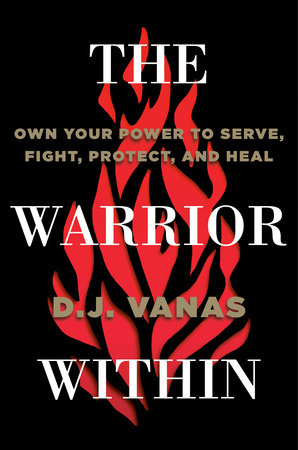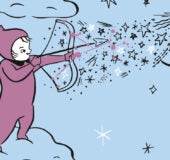Chapter 1: Own Your Warrior Spirit Putting It to Work One morning, while I was still in the Air Force, I woke up with what I thought was the beginning of a heat rash running from the right side of my torso to the top of my thigh. Immediately after waking up, the bumps and tracks started burning like they'd been touched by a match. It felt like liquid fire under my skin. It was excruciating, and I wouldn't have wished this on my worst enemy. I had shingles, and it tormented me for six weeks of living hell.
During that time, I was an active-duty Air Force captain, serving as chief of minority enrollment at the U.S. Air Force Academy, my alma mater, where I led a full-time team of ten junior officers and advised a field team of another hundred. At the same time, we were just starting a family, and to complicate matters, I was also in the process of launching a new speaking and consulting business. I was committed to making a difference in the world by both serving with distinction in my military role and creating a business to impact communities, organizations, and individual lives in a positive, meaningful way.
In other words, I wanted to do it all, and I sure tried. I would get up at four in the morning to work on the business for three hours before going in to work. Then I would lead my team during the day, come home at five, and continue to work on the business until ten or eleven at night. I even worked on the business through the weekends, creating content, fine-tuning my programs, and building a database of contacts. But I felt the constant pulling tear of going in several directions at once, the overwhelming feeling of having too much on my plate, and the agonizing frustration of trying so hard to do my best for those I was responsible for serving. It was slowly breaking me down.
The more frustrated I got, the harder I worked, but the more I neglected myself, the more depleted I became. Eventually, I developed every classic sign of stress-headaches, upset stomach, restlessness, agitation, lack of focus. I was drinking Maalox and Pepto Bismol like they were protein shakes, eating Tums and Rolaids like candy, and kept saying, "I'll take care of myself later." I so desperately wanted to make an impact, to make a positive difference-and it was killing me.
Later showed up with a vengeance, and I suffered greatly for it. I was twenty-eight at the time, and the doctor I saw explained that shingles, the resurgence of chicken pox due to stress, was usually something we get when we're older and our immunity isn't as strong. He asked me point-blank, "What are you doing to yourself?"
My intentions to serve were good, but my execution had become a mess. Through that experience, I learned a hard truth: We can't be warriors when we're falling apart.
If you have a job that others depend on, and you serve in roles where your efforts have real-world impact and your best is required every day, even when you're not "feeling it"—this book is for you. Whether you're a frontline healthcare worker, a teacher advocating for education reform, an engineer coming up with new ways to insulate our cities from the effects of climate change, a deployed military member protecting our country, a dedicated government employee, a leader of a business team, or a social worker trying to help families stay together-if youÕre fighting to make a positive impact, you can do it consistently only when you own your own need to get yourself right.
I've met thousands of rising, established, and retired stars in healthcare, government, education, social work, and other service industries, and I've found that, almost without exception, everyone has experienced the painful, and sometimes dangerous, effects of having our intentions and execution out of alignment. The intention to serve was there, but they ultimately couldn't deliver because they weren't taking care of themselves in the process. Many of those I interviewed mentioned experiencing the battle damage of unaddressed health and wellness needs, from relationship and sleep problems to migraines, to becoming overweight due to stress eating, to experiencing a terrifying wave of ministrokes as a result of pushing beyond what they could bear.
When there is a strong will and intention to serve, there must also be an equally strong will and intention to serve the right way. This means honoring and following a set of principles that will keep you resilient, healthy, energized, and able to sustain the good fight. Without it, you suffer and fall short. Instead of being an asset and contributor to your tribe, you become a detriment to it. We can't respond to threats, leverage opportunities, serve others well, or navigate crises if we're already in a crisis ourselves.
Learning this lesson for myself inspired me to create the model that I'm sharing with you in this book. I looked to the past and found beautiful principles and a time-tested framework of perseverance and resilience through chaos followed by our warriors in tribal communities that enabled them to endure against incredible odds and unbelievable obstacles and remain resilient and effective. I found solutions to keep us strong in the fight, stay balanced, serve at our best through chaos, keep improving, and enjoy our lives of service so much more through the process. It's worked wonders for me and resonated deeply with thousands of service providers when they understand that the role of warriors can make us warriors in our roles. It can work for you too. These principles require no special background, affiliation, or training and are available for anyone choosing to use and benefit from them. And they are needed.
Before we learn how to become warriors in our roles, we must first learn what a warrior is. And that begins with breaking down what a warrior is not.
What a Warrior Is Not The word "warrior" is loaded with emotion and comes with a host of dangerous expectations, behaviors, and stereotypes. Throughout history, our Native American warriors have been constantly misrepresented, typically seen only through the lens of their fighting skills. In the media, Hollywood in particular, a warrior is often portrayed as a chiseled, fearless, and violent character who destroys scores of enemies and city blocks, who shoots eight million bullets, bazookas, bad guys, and surly looks at the camera, all in the name of glory.
These stereotypical media images not only foster toxic personas bent on dominating others, but they also create harmful and unrealistic expectations of perfection and invulnerability. Living out those harmful expectations leaves committed servants under tremendous pressure to not make mistakes, not ask for help-or even admit that they need it. This leaves those same people suffering in silence or working so hard they're burned out beyond repair, harming their health and relationships, and actually doing more damage than good.
A warrior isn't just a man's job Women are the birthplace and backbone of our tribal nations. They've always had a strong presence, serving as chiefs in matriarchal tribes, but rose to a special place of prominence after the Great Indian Wars. Many of our men were either killed or spiritually broken, having been disarmed and forced to farm, as hunting, our cultural and spiritual way of life, was greatly restricted or forbidden by the U.S. government and its institutions. Our women became full-fledged warriors in every sense of the word as they protected children, kept families intact, and fought to preserve our culture. They've been honorably fulfilling that role for almost 150 years and undoubtedly will continue to do so, not only in our tribal communities but also in government and military service, education, science, social services, healthcare, and leadership roles across industries.
Society in general continues to change, becoming more equitable and erasing stereotypical roles that locked women into fixed responsibilities and behaviors. As the proud father of two amazing daughters, I'm thrilled to see this change continue to progress. Warriors in our communities include Autumn Peltier (Anishinaabe/Wikwemikong First Nation in Canada), who was nominated for the International Children's Peace Prize at the age of thirteen and told the UN to "warrior up" in protecting clean drinking water for future generations. Wilma Mankiller (Cherokee) had her tires slashed and endured death threats to become the first woman elected to serve as principal chief of the Cherokee Nation. U.S. Army soldier Lori Ann Piestewa (Hopi) was the first Native American woman killed in combat on foreign soil during the war in Iraq.
There are countless warriors who don't fit into the warrior stereotype yet are making a positive impact in the world. This is a welcome evolution of the role, blunting the toxic masculinity that may have blighted this role in the past, making it inaccessible or unapproachable to our mighty women. The modern traditional warrior role would be incomplete without them.
A warrior isn't in it for the glory Think of all the work you do in your role. Let's be honest here. Most of what you do, you don't get credit for, right? But you do it anyway because you know it's the right thing to do and you've committed to doing it to the best of your ability. When we make a mistake, it seems we get called on it from every direction. But doing a great job in your role may feel like wetting your pants in a dark suit-it makes you feel warm and tingly but no one else really notices. That is tough, but when we know we're in it not for the glory but for the impact, it makes this reality much easier to navigate.
A warrior doesn't go at it alone
What can you do with a single finger? Poke an eye, pick your nose, or give someone "the finger." But you can't manipulate a doorknob, open a pickle jar, or hold someone's hand. You need your other fingers to do that. Going at it solo not only limits our ability to create impact but can also quickly lead us to what I call "overwhelm" and burnout. Our warriors understood the power of a tribe and never fought alone for that reason.
A warrior isn't arrogant
When you're active, busy, and starting to get results, it is easy to drift into a mentality of dominance. Dominance can breed arrogance, where we place ourselves above all those who are fighting beside us to make a difference. If left unchecked, that arrogance can lead us to step on others to move ourselves forward or to get our way. Arrogance weakens our ability to collaborate with others and therefore our ability to serve effectively.
A warrior isn't bulletproof We must avoid the temptation to overromanticize the role of the warrior as we so often do. When we do that, we sell their character and achievements short and keep the warrior role out of reach. Our legendary warriors like Tecumseh, Crazy Horse, Osceola, and Chief Joseph are often cloaked in an aura of invincibility in which they needed no one and were impervious to hurts or doubts. But of course, they dealt with fear, faced pain, and stumbled. They needed outside resources, encouragement, and self-care, as do we all. They were human beings, not Hollywood superheroes.
What a Warrior Is A warrior is different from a fighter A warrior needs to be a fighter, but there is a difference between being a fighter and a warrior. A fighter is someone who leverages their time, talent, and effort toward an objective, and the primary beneficiary is that individual. This is critically important in self-improvement and spurs us to go back to school, leave bad relationships, get a better job, stand up for ourselves, or lose weight. We need to be willing and able to fight for the things that improve our life or else they don't happen.
However, fighting for the self is not the role of a warrior. Warriors take those hard-earned lessons and skills and use them to serve others and impact their world in a positive way.
My friend Nancy Griffin (Saginaw Chippewa) is a powerful example of how a fighter can become a warrior. She grew up in an abusive home and married an abuser. She wanted to serve and fight for others as a rehabilitation counselor to help those with disabilities get employment, but she first had to fight for herself. She went back to school, but says, "I would go to classes after being beat up, which was usually around finals, with black eyes, broken nose, and broken bones. You get to a place where you think this is all life has to offer." But a committed passion to serve pulled her through her fear, doubt, and painful situation.
Through lots of support, encouragement, and a warrior spirit in action, Nancy started making different choices, including a divorce. She decided to change her circumstances by changing her choices. "A medicine man prayed for me and told me I had a future, though many times I couldn't see beyond the moment." Nancy fought step-by-step to change her situation, get her education, and become a warrior equipped, trained, and able to serve others. Because of her, several hundred people have become successfully employed over the expanse of her career. At one point, Nancy had the highest success rate in the state of Michigan for minority youth getting and maintaining employment!
A warrior fights for something bigger than the self My people (Ottawa) called a warrior ogichidaa, and that term has little to do with what we see in the media portrayal mentioned earlier. It's not about being the toughest person, it's not about seeking glory, and it doesn't require a uniform or combat boots. A warrior is fully engaged in developing their talent and ability over a lifetime to become an asset to the "tribe" they serve. Today, that tribe might be your family, community, company, students, patients, clients, or taxpaying citizens. But make no mistake, we all have one to serve.
A warrior nurtures their warrior spirit In our tribal communities, the warrior role was a spiritual endeavor as much as anything else. Between ceremonies, prayer, sacrifices, and use of holy medicines, spirit was interwoven throughout all their actions and intentions. When our spirit is involved in an activity, the activity itself becomes a spiritual event, and we're answering to a higher power and higher purpose. We're all in. When we incorporate our own spiritual beliefs and practices into our efforts, they can pull us through pain and fear and help us get out of our own way to accomplish what we set out to do.
Your warrior spirit is the driving force to face and overcome challenges and to develop yourself so you can serve and contribute to your tribe. It is a can-do, persistent, resilient, optimistic, uncompromising attitude composed of grit, determination, love for what is fought for, consistent focus, courageous commitment, and a willingness to own mistakes. Your warrior spirit is that voice inside you that shouts, "I will find a way forward!" and surpasses motivation.
Copyright © 2022 by D.J. Vanas. All rights reserved. No part of this excerpt may be reproduced or reprinted without permission in writing from the publisher.






